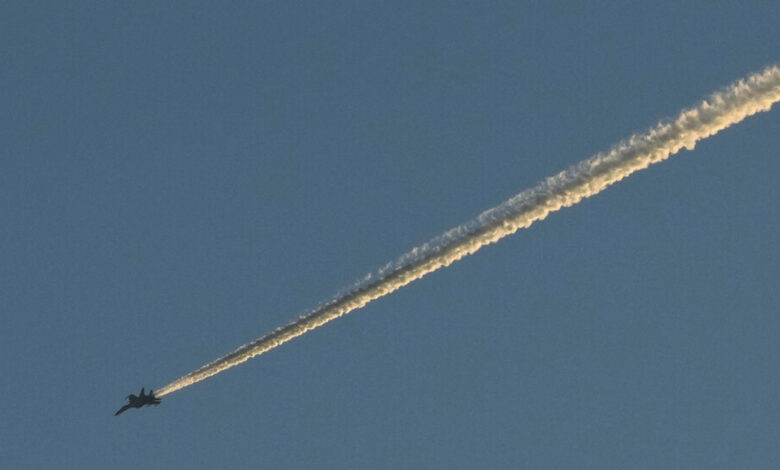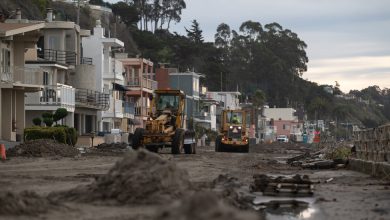Chinese Stages Show of Force Near Taiwan for a Third Day

China continued on Saturday to project its ire at House Speaker Nancy Pelosi’s recent visit to Taiwan, with its third straight day of military drills that have encroached ever closer to the island and raised concerns about potential conflict.
The Taiwanese defense ministry said on Saturday that several batches of Chinese military aircraft and warships had been detected around the Taiwan Strait, with some crossing the informal median line that divides the island from the Chinese mainland. They appeared to be engaged in an exercise simulating an attack on the main island of Taiwan, the ministry said.
Already, China’s show of force, which is expected to run through Sunday, has threatened territory that Taiwan considers its own more directly than any previous exercises had.
China has launched at least 11 missiles into the waters to the north, south and east of Taiwan, including at least one that flew over the island, though Taiwan said it was at a high altitude that constituted no threat. On Friday, it also deployed fighter jets, bombers, destroyers, drones and escort ships to waters near the island. Several of the zones the Chinese military designated for this week’s exercises are closer to the island than areas announced during the Taiwan Strait crisis in the mid-1990s, which also involved China firing missiles around Taiwan.
Since the exercises began on Thursday, at least 49 Chinese military jets have crossed the median line, according to Taiwanese officials.
Understand the China-Taiwan Tensions
What does China mean to Taiwan? China claims Taiwan, a self-governing island democracy of 23 million people, as its territory and has long vowed to take it back, by force if necessary. The island, to which Chiang Kai-shek’s Chinese forces retreated after the Communist Revolution of 1949, has never been part of the People’s Republic of China.
What does Xi Jinping want? China’s leader has made it clearer than any of his predecessors that he sees unifying Taiwan with China to be a primary goal of his rule — and a key to what he calls China’s “national rejuvenation.” Mr. Xi is also keen to project an image of strength ahead of his expected confirmation to an unprecedented third term this fall.
How is the U.S. involved? In an intentionally ambiguous diplomatic arrangement adopted in 1979, the United States maintains a “one China” policy that acknowledges, but does not endorse, Beijing’s claim over Taiwan. U.S. leaders have remained vague about how they would help Taiwan if China attacked, but President Biden has pledged to defend the island.
Why are tensions rising now? Speaker Nancy Pelosi’s recent trip to Taiwan has ignited regional tensions. She is the highest-level American official to visit the island since 1997. A chorus of official Chinese bodies portrayed her trip as part of an American effort to sabotage China’s efforts at unification with Taiwan.
How is China responding? A day after Ms. Pelosi’s trip, China began live-fire military drills near Taiwan, with missiles striking seas off the island, including five that landed in Japan’s exclusive economic zone waters. Amid growing international criticism, Beijing then sent warships and aircraft into waters and airspace near the island.
Taiwan’s foreign ministry said in a statement Saturday that China had “unilaterally created a crisis” by overreacting to Ms. Pelosi’s visit.
“The Taiwanese people have the right to befriend the rest of the world, and China has no right to interfere with the rest of the world befriending Taiwan,” the statement said.
The military exercises are the most visible element of the Chinese response to Ms. Pelosi’s trip to Taiwan, which she had said was intended to show support for the island and its vibrant democracy. Before her arrival on Tuesday, China had repeatedly warned that the gesture by Ms. Pelosi — the highest-ranking American official to visit Taiwan in 25 years — would provoke “serious consequences.” China claims Taiwan as its own territory, and China’s leader, Xi Jinping, has promised an eventual reunification, through force if necessary.
China also said on Friday that it would cancel or suspend talks with the United States on military coordination and climate change, which some analysts said could increase the chances of a miscommunication spiraling into a full-fledged crisis.
At the same time, the United States is looking to shore up its ties with other Asian countries, as a counterweight to China’s regional and global influence. On Saturday, Secretary of State Antony J. Blinken met with the president of the Philippines, Ferdinand Marcos Jr., in Manila. In a public exchange, Mr. Marcos told Mr. Blinken that he did not think Ms. Pelosi’s visit had “raised the intensity” of tensions in the region, which he said had already been high — an apparent rebuttal to China’s claims that the United States was responsible for the current frictions.
Fears that China would seek to physically prevent Ms. Pelosi’s visit were unrealized. But American officials remain concerned that the exercises, which began less than 24 hours after she left Taiwan, could still escalate, intentionally or accidentally, into more direct conflict.
Chinese officials, who have encouraged swaggering and at times virulent nationalism at home, may feel pressure to show that they are putting on a strong response. Some Chinese social media users have expressed disappointment or embarrassment that the government did not go further to prevent Ms. Pelosi’s visit; some made it clear that they had been expecting military action.
Even if the drills do not directly escalate into a full-blown crisis, they could signal a new pattern of aggression and incursions by the Chinese military. The Global Times, a state-run tabloid, said in an editorial on Friday that the work of promoting reunification with Taiwan had “entered a new stage.”
The United States has tried to avoid provoking China further. It has said that it remains committed to the status quo in Taiwan, acknowledging China’s stated claim to the island without recognizing it. The Pentagon ordered the U.S.S. Ronald Reagan to “remain on station” in the region, while maintaining some distance from the Taiwan Strait.
But China has made it clear that it regards any criticism of its exercises as an affront. It has summoned several ambassadors after their countries expressed concern about the drills. After some of the Chinese missiles landed on Thursday in waters that Japan claims as its own, leading Japan’s prime minister to call for an “immediate halt,” a representative for the Chinese Embassy in Japan told Japan not to “slide into the abyss” of geopolitical confrontation.
Amy Chang Chien, John Liu and Edward Wong contributed reporting.





